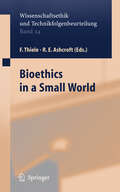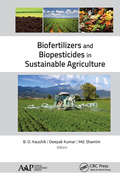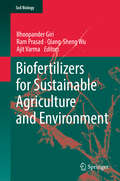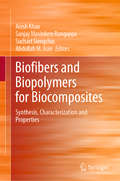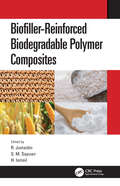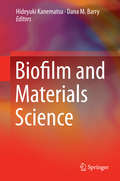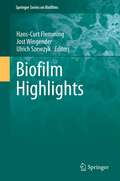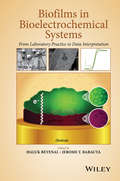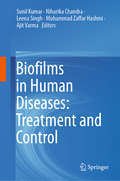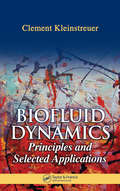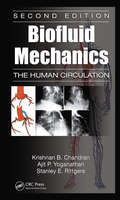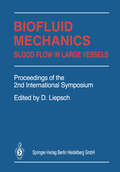- Table View
- List View
Biofertilizers: Study and Impact
by Inamuddin Mohd Imran Ahamed Rajender Boddula Mashallah RezakazemiGreat attention has been paid to reduce the use of conventional chemical fertilizers harming living beings through food chain supplements from the soil environment. Therefore, it is necessary to develop alternative sustainable fertilizers to enhance soil sustainability and agriculture productivity. Biofertilizers are the substance that contains microorganisms (bacteria, algae, and fungi) living or latent cells that can enrich the soil quality with nitrogen, phosphorous, potassium, organic matter, etc. They are a cost-effective, biodegradable, and renewable source of plant nutrients/supplements to improve the soil-health properties. Biofertilizers emerge as an attractive alternative to chemical fertilizers, and as a promising cost-effective technology for eco-friendly agriculture and a sustainable environment that holds microorganisms which enhance the soil nutrients’ solubility leading a raise in its fertility, stimulates crop growth and healthy food safety. This book provides in-depth knowledge about history and fundamentals to advances biofertilizers, including latest reviews, challenges, and future perspectives. It covers fabrication approaches, and various types of biofertilizers and their applications in agriculture, environment, forestry and industrial sectors. Also, organic farming, quality control, quality assurance, food safety and case-studies of biofertilizers are briefly discussed. Biofertilizers' physical properties, affecting factors, impact, and industry profiles in the market are well addressed. This book is an essential guide for farmers, agrochemists, environmental engineers, scientists, students, and faculty who would like to understand the science behind the sustainable fertilizers, soil chemistry and agroecology.
Biofertilizers: Study and Impact
by Inamuddin, Mohd Imran Ahamed Rajender Boddula Mashallah RezakazemiGreat attention has been paid to reduce the use of conventional chemical fertilizers harming living beings through food chain supplements from the soil environment. Therefore, it is necessary to develop alternative sustainable fertilizers to enhance soil sustainability and agriculture productivity. Biofertilizers are the substance that contains microorganisms (bacteria, algae, and fungi) living or latent cells that can enrich the soil quality with nitrogen, phosphorous, potassium, organic matter, etc. They are a cost-effective, biodegradable, and renewable source of plant nutrients/supplements to improve the soil-health properties. Biofertilizers emerge as an attractive alternative to chemical fertilizers, and as a promising cost-effective technology for eco-friendly agriculture and a sustainable environment that holds microorganisms which enhance the soil nutrients’ solubility leading a raise in its fertility, stimulates crop growth and healthy food safety. This book provides in-depth knowledge about history and fundamentals to advances biofertilizers, including latest reviews, challenges, and future perspectives. It covers fabrication approaches, and various types of biofertilizers and their applications in agriculture, environment, forestry and industrial sectors. Also, organic farming, quality control, quality assurance, food safety and case-studies of biofertilizers are briefly discussed. Biofertilizers' physical properties, affecting factors, impact, and industry profiles in the market are well addressed. This book is an essential guide for farmers, agrochemists, environmental engineers, scientists, students, and faculty who would like to understand the science behind the sustainable fertilizers, soil chemistry and agroecology.
Biofertilizers and Biopesticides in Sustainable Agriculture
by B. D. Kaushik Deepak Kumar ShamimThis new volume, Biofertilizers and Biopesticides in Sustainable Agriculture, presents strategies for the management of soil and crop diseases. Microbes have attracted worldwide attention due to their role in disease management and remediation of polluted soils. Taking a sustainable approach, this book explores the means of integrating various microbial management approaches to achieve the desired levels of crop yield under both conventional soils and neglected soils through the use of biopesticides and other botanicals as well as biomolecules. This book also presents a broad and updated view of molecular nitrogen fixation and phosphate-solubilizing and sulfur-transforming microbes for nutrition of crops in relation to the role of metal tolerant microbes in providing protection to plants grown in metal-contaminated soils. The preparation and application of biofertilizers, utilization of household waste materials, and use of genetically modified microorganisms (GMOs) in plant growth and development are also well discussed in the volume.
Biofertilizers and Biopesticides in Sustainable Agriculture
by B. D. Kaushik Deepak Kumar ShamimThis new volume, Biofertilizers and Biopesticides in Sustainable Agriculture, presents strategies for the management of soil and crop diseases. Microbes have attracted worldwide attention due to their role in disease management and remediation of polluted soils. Taking a sustainable approach, this book explores the means of integrating various microbial management approaches to achieve the desired levels of crop yield under both conventional soils and neglected soils through the use of biopesticides and other botanicals as well as biomolecules. This book also presents a broad and updated view of molecular nitrogen fixation and phosphate-solubilizing and sulfur-transforming microbes for nutrition of crops in relation to the role of metal tolerant microbes in providing protection to plants grown in metal-contaminated soils. The preparation and application of biofertilizers, utilization of household waste materials, and use of genetically modified microorganisms (GMOs) in plant growth and development are also well discussed in the volume.
Biofertilizers for Sustainable Agriculture and Environment (Soil Biology #55)
by Bhoopander Giri Ram Prasad Qiang-Sheng Wu Ajit VarmaThis book provides a comprehensive overview of the benefits of biofertilizers as an alternative to chemical fertilizers and pesticides.Agricultural production has increased massively over the last century due to increased use of chemical fertilizers and pesticides, but these gains have come at a price. The chemicals are not only expensive; they also reduce microbial activity in agricultural soils and accumulate in the food chain, with potentially harmful effects for humans. Accordingly, it is high time to explore alternatives and to find solutions to overcome our increasing dependence on these chemicals.Biofertilizers, which consist of plant remains, organic matter and microorganisms, might offer an alternative. They are natural, organic, biodegradable, eco-friendly and cost-effective. Further, the microbes present in the biofertilizers are important, because they produce nutrients required for plant growth (e.g., nitrogen, phosphorus, potassium), as well as substances essential for plant growth and development (e.g., auxins and cytokinins). Biofertilizers also improve the physical properties, fertility and productivity of soil, reducing the need for chemical fertilizers while maintaining high crop yield. This makes biofertilizers a powerful tool for sustainable agriculture and a sustainable environment.The book covers the latest research on biofertilizers, ranging from beneficial fungal, bacterial and algal inoculants; to microbes for bioremediation, wastewater treatment; and recycling of biodegradable municipal, agricultural and industrial waste; as well as biocontrol agents and bio-pesticides. As such, it offers a valuable resource for researchers, academics and students in the broad fields of microbiology and agriculture.
Biofibers and Biopolymers for Biocomposites: Synthesis, Characterization and Properties
by Anish Khan Sanjay Mavinkere Rangappa Suchart Siengchin Abdullah M. AsiriThis book summarizes recent developments in epoxy blends. It emphasizes new challenges for the synthesis, characterization, and properties of biofibers and biopolymers. It provides updates on all the important areas of biofibers and biopolymers in a comprehensive fashion, including synthesis, processing, characterisation and application. It provides a a one-stop reference for researchers and those working in industry and government. The book correlates macro, micro and nanostructure properties. Moreover, it provides cutting edge research from experts around the globe. The current status, trends, future directions and opportunities are discussed in detail, making the book also accessible for beginners to the subject and young researchers.
Biofiller-Reinforced Biodegradable Polymer Composites
by R. JumaidinPresenting a comprehensive overview of the field, Biofiller-Reinforced Biodegradable Polymer Composites examines biodegradable composites derived from biofiller and biodegradable polymers while providing critical information for efficient use of biocomposites developed from natural resources. Discusses advanced techniques for the use of both biofiller and biodegradable polymers as the matrix for composites. Highlights application of both natural fiber and natural matrix for composites in the development of environmentally friendly and sustainable materials. Introduces the basics of biocomposites, the processing and characteristics of new composite materials, and new combinations of composites such as soy protein and nanocellulose. Elaborates on the introduction of new materials to develop biodegradable polymers. This book has been written for researchers, advanced students, and professional engineers and materials scientists working in the area of bio-based polymers, natural fiber composites, and biocomposites.
Biofiller-Reinforced Biodegradable Polymer Composites
by R. Jumaidin S. M. Sapuan H. IsmailPresenting a comprehensive overview of the field, Biofiller-Reinforced Biodegradable Polymer Composites examines biodegradable composites derived from biofiller and biodegradable polymers while providing critical information for efficient use of biocomposites developed from natural resources. Discusses advanced techniques for the use of both biofiller and biodegradable polymers as the matrix for composites. Highlights application of both natural fiber and natural matrix for composites in the development of environmentally friendly and sustainable materials. Introduces the basics of biocomposites, the processing and characteristics of new composite materials, and new combinations of composites such as soy protein and nanocellulose. Elaborates on the introduction of new materials to develop biodegradable polymers. This book has been written for researchers, advanced students, and professional engineers and materials scientists working in the area of bio-based polymers, natural fiber composites, and biocomposites.
Biofilm and Materials Science
by Hideyuki Kanematsu Dana M. BarryThis book explains the formation of biofilm on materials surfaces in an industrial setting. The authors describe new developments in understanding of biofilm formation, detection, and control from the viewpoint of materials science and engineering. The book details the range of issues caused by biofilm formation and the variety of affected industries.
Biofilm Highlights (Springer Series on Biofilms #5)
by Hans-Curt Flemming, Jost Wingender and Ulrich SzewzykLiving in biofilms is the common way of life of microorganisms, transiently immobilized in their matrix of extracellular polymeric substances (EPS), interacting in many ways and using the matrix as an external digestion and protection system. This is how they have organized their life in the environment, in the medical context and in technical systems – and has helped make them the oldest, most successful and ubiquitous form of life. In this book, hot spots in current biofilm research are presented in critical and sometimes provocative chapters. This serves a twofold purpose: to provide an overview and to inspire further discussions. Above all, the book seeks to stimulate lateral thinking.
Biofilms in Bioelectrochemical Systems: From Laboratory Practice to Data Interpretation
by Haluk Beyenal Jerome T. BabautaThis book serves as a manual of research techniques for electrochemically active biofilm research. Using examples from real biofilm research to illustrate the techniques used for electrochemically active biofilms, this book is of most use to researchers and educators studying microbial fuel cell and bioelectrochemical systems. The book emphasizes the theoretical principles of bioelectrochemistry, experimental procedures and tools useful in quantifying electron transfer processes in biofilms, and mathematical modeling of electron transfer in biofilms. It is divided into three sections: Biofilms: Microbiology and microbioelectrochemistry - Focuses on the microbiologic aspect of electrochemically active biofilms and details the key points of biofilm preparation and electrochemical measurement Electrochemical techniques to study electron transfer processes - Focuses on electrochemical characterization and data interpretation, highlighting key factors in the experimental procedures that affect reproducibility Applications - Focuses on applications of electrochemically active biofilms and development of custom tools to study electrochemically active biofilms. Chapters detail how to build the reactors for applications and measure parameters
Biofilms in Bioelectrochemical Systems: From Laboratory Practice to Data Interpretation
by Haluk Beyenal Jerome T. BabautaThis book serves as a manual of research techniques for electrochemically active biofilm research. Using examples from real biofilm research to illustrate the techniques used for electrochemically active biofilms, this book is of most use to researchers and educators studying microbial fuel cell and bioelectrochemical systems. The book emphasizes the theoretical principles of bioelectrochemistry, experimental procedures and tools useful in quantifying electron transfer processes in biofilms, and mathematical modeling of electron transfer in biofilms. It is divided into three sections: Biofilms: Microbiology and microbioelectrochemistry - Focuses on the microbiologic aspect of electrochemically active biofilms and details the key points of biofilm preparation and electrochemical measurement Electrochemical techniques to study electron transfer processes - Focuses on electrochemical characterization and data interpretation, highlighting key factors in the experimental procedures that affect reproducibility Applications - Focuses on applications of electrochemically active biofilms and development of custom tools to study electrochemically active biofilms. Chapters detail how to build the reactors for applications and measure parameters
Biofilms in Human Diseases: Treatment and Control
by Sunil Kumar Niharika Chandra Leena Singh Muhammad Zaffar Hashmi Ajit VarmaThis book highlights treatment strategies for bacterial biofilms in connection with a variety of human diseases. In particular, it reviews bacterial biofilm formation and its mechanism. Topics covered include biofilms in human health, the role of biofilms in mediating human diseases, and methods for testing bacterial biofilms. Further sections concentrate on biofilm-mediated diseases in different parts of the human gastrointestinal tract, while therapeutic strategies for biofilm control and natural agents that disrupt bacterial biofilms are also covered. Readers will also find the latest advances in probiotics and biofilms, as well as the use of probiotics to counteract biofilm-associated infections. Biofilms and antimicrobial resistance are discussed. Subsequent chapters address the management of inflammatory bowel disease via probiotics biofilms, as well as the role of probiotics bacteria in the treatment of human diseases associated with bacterial biofilms. The book is chiefly intended for clinicians/scientists in the fields of medical microbiology, applied microbiology, biochemistry, and biotechnology.
Biofilms in the Dairy Industry (Society of Dairy Technology)
by Koon Hoong Teh Steve Flint John Brooks Geoff KnightIn recent years, the formation and impacts of biofilms on dairy manufacturing have been studied extensively, from the effects of microbial enzymes produced during transportation of raw milk to the mechanisms of biofilm formation by thermophilic spore-forming bacteria. The dairy industry now has a better understanding of biofilms and of approaches that may be adopted to reduce the impacts that biofilms have on manufacturing efficiencies and the quality of dairy products. Biofilms in the Dairy Industry provides a comprehensive overview of biofilm-related issues facing the dairy sector. The book is a cornerstone for a better understanding of the current science and of ways to reduce the occurrence of biofilms associated with dairy manufacturing. The introductory section covers the definition and basic concepts of biofilm formation and development, and provides an overview of problems caused by the occurrence of biofilms along the dairy manufacturing chain. The second section of the book focuses on specific biofilm-related issues, including the quality of raw milk influenced by biofilms, biofilm formation by thermoduric streptococci and thermophilic spore-forming bacteria in dairy manufacturing plants, the presence of pathogens in biofilms, and biofilms associated with dairy waste effluent. The final section of the book looks at the application of modelling approaches to control biofilms. Potential solutions for reducing contamination throughout the dairy manufacturing chain are also presented. Essential to professionals in the global dairy sector, Biofilms in the Dairy Industry will be of great interest to anyone in the food and beverage, academic and government sectors. This text is specifically targeted at dairy professionals who aim to improve the quality and consistency of dairy products and improve the efficiency of dairy product manufacture through optimizing the use of dairy manufacturing plant and reducing operating costs.
Biofilms in the Dairy Industry (Society of Dairy Technology)
by Koon Hoong Teh Steve Flint John Brooks Geoff KnightIn recent years, the formation and impacts of biofilms on dairy manufacturing have been studied extensively, from the effects of microbial enzymes produced during transportation of raw milk to the mechanisms of biofilm formation by thermophilic spore-forming bacteria. The dairy industry now has a better understanding of biofilms and of approaches that may be adopted to reduce the impacts that biofilms have on manufacturing efficiencies and the quality of dairy products. Biofilms in the Dairy Industry provides a comprehensive overview of biofilm-related issues facing the dairy sector. The book is a cornerstone for a better understanding of the current science and of ways to reduce the occurrence of biofilms associated with dairy manufacturing. The introductory section covers the definition and basic concepts of biofilm formation and development, and provides an overview of problems caused by the occurrence of biofilms along the dairy manufacturing chain. The second section of the book focuses on specific biofilm-related issues, including the quality of raw milk influenced by biofilms, biofilm formation by thermoduric streptococci and thermophilic spore-forming bacteria in dairy manufacturing plants, the presence of pathogens in biofilms, and biofilms associated with dairy waste effluent. The final section of the book looks at the application of modelling approaches to control biofilms. Potential solutions for reducing contamination throughout the dairy manufacturing chain are also presented. Essential to professionals in the global dairy sector, Biofilms in the Dairy Industry will be of great interest to anyone in the food and beverage, academic and government sectors. This text is specifically targeted at dairy professionals who aim to improve the quality and consistency of dairy products and improve the efficiency of dairy product manufacture through optimizing the use of dairy manufacturing plant and reducing operating costs.
Biofilms in the Food Environment (Institute of Food Technologists Series)
by Anthony L. Pometto III Ali DemirciIn nature, microorganisms are generally found attached to surfaces as biofilms such as dust, insects, plants, animals and rocks, rather than suspended in solution. Once a biofilm is developed, other microorganisms are free to attach and benefit from this microbial community. The food industry, which has a rich supply of nutrients, solid surfaces, and raw materials constantly entering and moving through the facility, is an ideal environment for biofilm development, which can potentially protect food pathogens from sanitizers and result in the spread of foodborne illness. Biofilms in the Food Environment is designed to provide researchers in academia, federal research labs, and industry with an understanding of the impact, control, and hurdles of biofilms in the food environment. Key to biofilm control is an understanding of its development. The goal of this 2nd edition is to expand and complement the topics presented in the original book. Readers will find: The first comprehensive review of biofilm development by Campylobacter jejuni An up-date on the resistance of Listeria monocytogenes to sanitizing agents, which continues to be a major concern to the food industry An account of biofilms associated with various food groups such as dairy, meat, vegetables and fruit is of global concern A description of two novel methods to control biofilms in the food environment: bio-nanoparticle technology and bacteriophage Biofilms are not always a problem: sometimes they even desirable. In the human gut they are essential to our survival and provide access to some key nutrients from the food we consume. The authors provide up-date information on the use of biofilms for the production of value-added products via microbial fermentations. Biofilms cannot be ignored when addressing a foodborne outbreak. All the authors for each chapter are experts in their field of research. The Editors' hope is that this second edition will provide the bases and understanding for much needed future research in the critical area of "Biofilm in Food Environment".
Biofilms in the Food Environment (Institute of Food Technologists Series)
by Anthony L. Pometto III Ali DemirciIn nature, microorganisms are generally found attached to surfaces as biofilms such as dust, insects, plants, animals and rocks, rather than suspended in solution. Once a biofilm is developed, other microorganisms are free to attach and benefit from this microbial community. The food industry, which has a rich supply of nutrients, solid surfaces, and raw materials constantly entering and moving through the facility, is an ideal environment for biofilm development, which can potentially protect food pathogens from sanitizers and result in the spread of foodborne illness. Biofilms in the Food Environment is designed to provide researchers in academia, federal research labs, and industry with an understanding of the impact, control, and hurdles of biofilms in the food environment. Key to biofilm control is an understanding of its development. The goal of this 2nd edition is to expand and complement the topics presented in the original book. Readers will find: The first comprehensive review of biofilm development by Campylobacter jejuni An up-date on the resistance of Listeria monocytogenes to sanitizing agents, which continues to be a major concern to the food industry An account of biofilms associated with various food groups such as dairy, meat, vegetables and fruit is of global concern A description of two novel methods to control biofilms in the food environment: bio-nanoparticle technology and bacteriophage Biofilms are not always a problem: sometimes they even desirable. In the human gut they are essential to our survival and provide access to some key nutrients from the food we consume. The authors provide up-date information on the use of biofilms for the production of value-added products via microbial fermentations. Biofilms cannot be ignored when addressing a foodborne outbreak. All the authors for each chapter are experts in their field of research. The Editors' hope is that this second edition will provide the bases and understanding for much needed future research in the critical area of "Biofilm in Food Environment".
Biofluid Dynamics: Principles and Selected Applications
by Clement KleinstreuerRequiring only an introductory background in continuum mechanics, including thermodynamics, fluid mechanics, and solid mechanics, Biofluid Dynamics: Principles and Selected Applications contains review, methodology, and application chapters to build a solid understanding of medical implants and devices. For additional assistance, it includes a glos
Biofluid Mechanics: The Human Circulation, Second Edition
by Krishnan B. Chandran Stanley E. Rittgers Ajit P. YoganathanDesigned for senior undergraduate or first-year graduate students in biomedical engineering, Biofluid Mechanics: The Human Circulation, Second Edition teaches students how fluid mechanics is applied to the study of the human circulatory system. Reflecting changes in the field since the publication of its predecessor, this second edition has been ex
Biofluid Mechanics: The Human Circulation, Second Edition
by Krishnan B. Chandran Stanley E. Rittgers Ajit P. YoganathanDesigned for senior undergraduate or first-year graduate students in biomedical engineering, Biofluid Mechanics: The Human Circulation, Second Edition teaches students how fluid mechanics is applied to the study of the human circulatory system. Reflecting changes in the field since the publication of its predecessor, this second edition has been ex
Biofluid Mechanics: Blood Flow in Large Vessels
by Dieter W. LiepschProceedings of the 2nd International Symposium Biofluid Mechanics and Biorheology. June 25-28, 1989, Munich
Biofluid Mechanics · 2
by D. J. SchneckThe Department of Engineering Science and Hechanics at Virginia Polytechnic Institute and State University spon sored the First Mid-Atlantic Conference on Bio-Fluid Mechanics, which was held in Blacksburg, Virginia during the period 9-11 August 1978. Some 40 life-scientists, engineers, physicians and others who share a common interest in the advancement of basic and applied knowledge in bio fluid mechanics gathered at the Donaldson Brown Center for Continuing Education to hear 25 papers presented in seven technical sessions. At the conclusion of the conference, those present decided unanimously that its success warranted having at least one more -- and that it was conceptually a sound idea to plan it on a biennial basis for late spring. Hence, the second Mid-Atlantic Conference on Bio Fluid Mechanics took place at Virginia Tech on May 4-6, 1980. This volume documents the Proceedings of the second conference. It contains full texts of 23 contributed papers, 2 guest lectures and 1 invited seminar. The papers are gr9uped according to subject matter, beginning with 3 in the area of respiration, followed by 1 in kidney dialysis, 1 in reproduction, 1 in joint lubrication, 1 in prosthetic fluidics, 2 in zoology, and ending with 14 in the general field of cardiovascular dynamics. Of the latter, 5 deal with the subject of heart valves, 2 concern themselves with the microcirculation, 6 address vascular system hemodynamics and 1 covers some aspects of blood rheology.
Biofluidmechanik: Grundlagen und Anwendungen
by Dieter LiepschDieses Buch führt Sie in die Grundlagen der Biofluidmechanik einWie funktioniert der menschliche Blutkreislauf? Wie arbeiten Mikrozirkulationsvorgänge? Mit diesen und vielen weiteren Fragen der Strömungsuntersuchung beschäftigt sich die Biofluidmechanik. Dieses Buch gewährt ihnen interessante Einblicke in die Grundlagen der Biofluidmechanik.Die Biofluidmechanik ist eine thematisch sehr breit gestaffelte Wissenschaft. Sie erforscht die Gesetzmäßigkeiten der Bewegung, des Kräftegleichgewichtes und der Strömungstechnik von Fluiden. Hierzu gehören unter anderem:• Atmung• Blutkreislauf• Mikrozirkulationsvorgänge• Lymphströmungen• Künstliche Gefäßersatze• Gefäßprothesen aus verschiedenen Materialien• Künstliche Herzklappen• Urologische Messungen• Künstliche Harnleiter• Blutrheologie• Transport durch Membranen• Bewegung geladener Partikel• Ionen in Lösungen• Vibrationen• Wellenfortpflanzung und SchockwellenWichtiges Grundlagenwissen der Biofluidmechanik in einem Buch In seinem Buch gibt der Autor einen ausführlichen Überblick über die Grundlagen der Biofluidmechanik und stellt die folgenden Themen detailliert vor:• Einleitung in die Biofluidmechanik• Physikalische Grundlagen von Fluiden• Rheologische Grundlagen• Biofluide (Körperflüssigkeiten) in Menschen und Tieren• Grundlegende theoretische Fluid- bzw. hämodynamische Betrachtungen• Medizinische Grundlagen, menschliches Kreislaufsystem, Blutgefäße, Herz, Lungenmechanik und Atmung• Besonderheiten und Messmethoden der Biofluidmechanik• Anwendungen und Beispiele in Modellen, diagnostische und therapeutische BedeutungAufgrund des hohen Praxisbezugs ist dieses Buch über die Biofluidmechanik nicht nur für Studenten, sondern auch für Beschäftigte in Gesundheitsforschung und Medizin ein wichtiges und hilfreiches Grundlagenwerk.
Biofoams: Science and Applications of Bio-Based Cellular and Porous Materials
by Salvatore Iannace Chul B. ParkAddresses a Growing Need for the Development of Cellular and Porous Materials in IndustryBuilding blocks used by nature are motivating researchers to create bio-inspired cellular structures that can be used in the development of products for the plastic, food, and biomedical industry. Representing a unified effort by international experts, Biofoams
